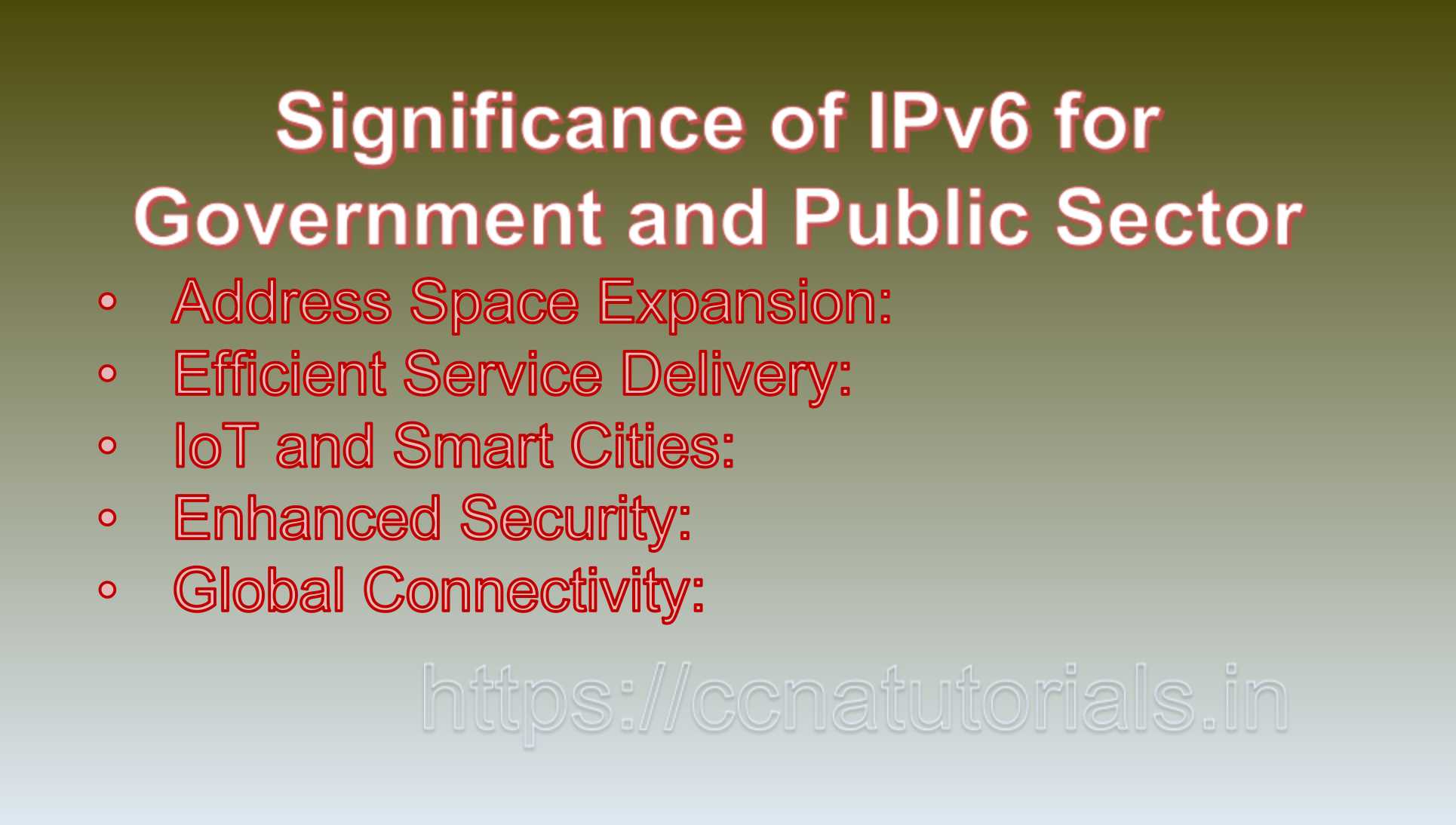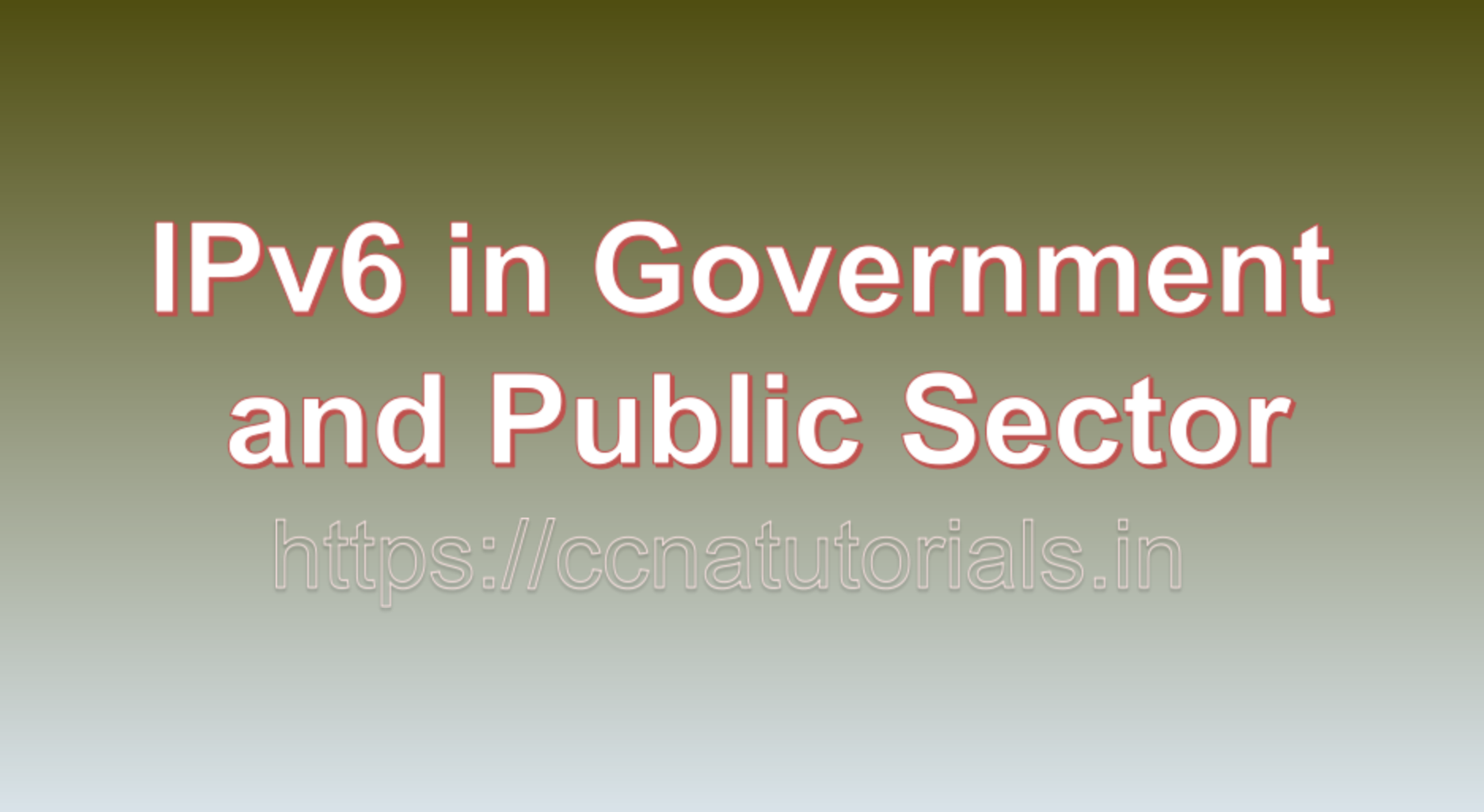Contents of this article
in this article, I describe IPv6 in Government and Public Sector, Embracing the Future of Internet Connectivity. In today’s digital age, where governments and public sector organizations are increasingly relying on technology to deliver services, manage data, and communicate with citizens, the need for a robust and sustainable internet infrastructure has never been greater. The Internet Protocol version 6 (IPv6) presents a pivotal solution to address the challenges posed by the exhaustion of IPv4 addresses and to accommodate the growing demand for connectivity brought about by the proliferation of internet-connected devices. This article delves into the significance of adoption of IPv6 in government and public sector, highlighting its benefits, challenges, and implications for efficient governance and service delivery.
The Significance of IPv6 for Government and Public Sector
1. Address Space Expansion:
The most immediate and pressing issue addressed by IPv6 is the exhaustion of available IPv4 addresses. IPv6’s significantly larger address space provides an abundance of unique addresses, ensuring that government agencies and public sector entities can allocate addresses freely without the constraints faced by IPv4. This expansion facilitates the growth of online services, accommodates increasing numbers of devices, and enables seamless communication within government networks.
2. Efficient Service Delivery:
Government agencies are entrusted with delivering a wide array of public services, ranging from healthcare and education to disaster management and public safety. IPv6 enables efficient and secure delivery of these services by providing each device a unique address, streamlining communication and data exchange. This results in improved service accessibility, reduced latency, and enhanced user experiences.
3. IoT and Smart Cities:
The advent of the Internet of Things (IoT) and the concept of smart cities has transformed urban governance. IPv6’s address space can accommodate the countless sensors, devices, and infrastructure components that make up smart city ecosystems. Governments can use IPv6 to monitor and manage traffic, utilities, waste management, and more, leading to improved urban planning and resource utilization.
4. Enhanced Security:
IPv6 incorporates modern security features, such as IPsec, into its core design. This facilitates secure communication between devices and networks, safeguarding sensitive government data from potential cyber threats. As governments handle confidential citizen information, secure communication becomes paramount, and IPv6 offers a more robust foundation for data protection.
5. Global Connectivity:
Governments engage in international collaborations, trade, and diplomacy. IPv6’s adoption enables seamless global connectivity, eliminating the complexities of network address translation (NAT) that can hinder communication across different address formats. This ensures that government agencies can effectively communicate and collaborate on an international scale.
Challenges in IPv6 Adoption
1. Technical Transition:
While IPv6 presents significant advantages, its adoption requires a technical transition from IPv4. This process involves configuring networks, updating hardware and software, and ensuring compatibility with existing systems. The public sector may face challenges in managing this transition, particularly in older legacy systems.
2. Training and Awareness:
Implementing IPv6 necessitates training IT staff and personnel to understand the intricacies of the new protocol. This requires time, resources, and a concerted effort to raise awareness about the benefits and importance of IPv6 across government agencies and public sector entities.
3. Budgetary Constraints:
Government budgets are often tightly allocated, making it challenging to allocate resources for large-scale infrastructure upgrades. IPv6 implementation requires funding for equipment, training, and technical support. Convincing budget decision-makers of the long-term benefits may be an obstacle.
4. Vendor Support:
Not all hardware and software vendors provide comprehensive IPv6 support. This can lead to compatibility issues and limitations in the implementation of certain applications. Governments need to collaborate with vendors to ensure that essential software and services are IPv6 compatible.
5. Coordination and Policy:
The public sector often encompasses numerous agencies, each with its own IT infrastructure and policies. Coordinating IPv6 adoption efforts across these entities can be complex. Establishing overarching policies and guidelines for IPv6 adoption can streamline the process.
Policy Implications and Strategies
1. National IPv6 Strategy:
Governments can formulate a national IPv6 strategy that outlines the objectives, timelines, and responsibilities for IPv6 adoption across government agencies and public sector organizations. This strategy should encompass technical, financial, and human resource considerations.
2. Mandatory IPv6 Compliance:
Requiring government agencies to adhere to IPv6 standards when developing new applications, services, and infrastructure can expedite the adoption process. This approach ensures that future systems are IPv6-ready from the outset.
3. Capacity Building:
Governments should invest in training programs and workshops to equip IT personnel and decision-makers with the knowledge and skills required for successful IPv6 implementation. This includes raising awareness about the benefits of IPv6 and providing technical training.
4. Collaboration with RIRs and ISPs:
Governments can collaborate with Regional Internet Registries (RIRs) and Internet Service Providers (ISPs) to ensure the availability of IPv6 addresses and to facilitate the transition process. ISPs play a vital role in providing IPv6 connectivity to end-users.
5. Public-Private Partnerships:
Engaging with the private sector can bring expertise and resources to the table. Public-private partnerships can aid in addressing challenges and accelerating IPv6 adoption by leveraging industry knowledge and best practices.
In short, IPv6 in Government and Public Sector
IPv6 adoption in government and public sector is not merely a technical upgrade. it is a strategic move that aligns with the goals of efficient service delivery, enhanced security, and global connectivity. Despite the challenges, the benefits of IPv6 far outweigh the costs, and governments that embrace this transition position themselves for a future characterized by innovation and seamless digital interactions with citizens and stakeholders. By formulating comprehensive policies, fostering collaboration, and investing in capacity building, governments can navigate the complexities of IPv6 adoption and pave the way for a more connected, secure, and efficient public sector.

IPv6 in Government and Public Sector in other terms
In an increasingly interconnected world, governments and public sectors are embracing digital transformation to enhance service delivery, increase efficiency, and better engage with citizens. A crucial element of this transformation is the adoption of Internet Protocol version 6 (IPv6). IPv6 offers a larger address space, improved security features, and support for the growing number of connected devices. This article explores the significance of IPv6 in the government and public sector, its benefits, challenges, and its role in shaping the future of digital governance.
The Need for IPv6 in Government sector
Governments worldwide are leveraging technology to modernize their operations, from citizen services to internal communication. However, the widespread proliferation of devices, from smartphones to IoT sensors, strains the limited address resources of IPv4. IPv6’s massive address space (128 bits compared to IPv4’s 32 bits) is a solution to this problem, enabling governments to accommodate the growing number of connected devices without the complexity of network address translation (NAT) that IPv4 often requires.
Benefits of IPv6 Adoption:
1. Address Space Abundance:
The sheer number of unique IPv6 addresses eliminates the need for address conservation measures. This simplifies network management and enables governments to allocate addresses more liberally, supporting innovative initiatives such as smart cities and IoT projects.
2. Security Enhancements:
IPv6 incorporates security features like IPsec (Internet Protocol Security) as a mandatory part of the protocol. This ensures encrypted and authenticated communication, safeguarding sensitive government data and citizen information.
3. Efficient Routing:
IPv6’s hierarchical addressing structure facilitates efficient routing, reducing the load on routers and enhancing network performance. This is particularly beneficial for government agencies that require reliable and fast communication.
4. End-to-End Connectivity:
IPv6 enables end-to-end communication without the need for NAT. This feature simplifies peer-to-peer communication, enhancing applications and services that rely on direct connections.
5. IoT and Smart Services:
Governments are increasingly adopting IoT solutions for various applications, including public safety, infrastructure management, and environmental monitoring. IPv6’s abundant address space is essential for accommodating the vast number of devices and sensors in these initiatives.
6. Global Interoperability:
IPv6 is a globally recognized standard, fostering interoperability and compatibility across different networks, services, and devices. This is crucial for international collaborations and information sharing.
IPv6 Implementation Challenges and Strategies:
1. Legacy Infrastructure:
Governments often have legacy systems and networks built on IPv4. Migrating these systems to IPv6 requires careful planning to ensure minimal disruption. Dual-stack deployment, where both IPv4 and IPv6 coexist, can facilitate a smoother transition.
2. Awareness and Training:
To successfully adopt IPv6, government IT teams need to be trained and educated about its features, benefits, and implementation best practices.
3. Vendor Support:
Ensuring that hardware and software vendors provide IPv6-compatible solutions is essential for a seamless transition. Governments should incorporate IPv6 support as a requirement in procurement processes.
4. Policy and Governance:
Developing comprehensive IPv6 policies and governance frameworks helps guide the implementation, management, and security aspects of IPv6 adoption.
5. Collaboration:
Government agencies should collaborate with regional internet registries (RIRs), industry experts, and other governments that have successfully implemented IPv6 to share insights and lessons learned.
Case Studies for IPv6 in Government and Public Sector
1. United States Government:
The U.S. government initiated the “IPv6-Only Federal Agency” program, urging federal agencies to transition to IPv6-only network architectures. This push accelerates the adoption of IPv6 and lays the groundwork for modern digital services.
2. European Union (EU):
The European Commission encourages EU member states to adopt IPv6 to support the Digital Single Market strategy. The EU promotes awareness, provides resources, and monitors the progress of IPv6 adoption.
3. South Korea:
The South Korean government has been a pioneer in IPv6 adoption, aiming to establish a ubiquitous network environment. Their efforts include substantial investments in research and development, as well as encouraging private sector engagement.
4. India:
The Indian government recognizes the importance of IPv6 for its Digital India initiative. It emphasizes the need for government websites and applications to be IPv6-compatible to ensure seamless access for citizens.
Conclusion for IPv6 in Government and Public Sector:
In an era of rapid technological advancement, IPv6 has emerged as a critical enabler of the government’s digital transformation efforts. Its abundant address space, security features, and support for emerging technologies position it as the foundation for building resilient and future-ready digital services. While challenges exist, governments can learn from successful implementations worldwide and develop strategies that align with their unique needs. By adopting IPv6, governments can pave the way for a connected, efficient, and citizen-centric future of digital governance.






